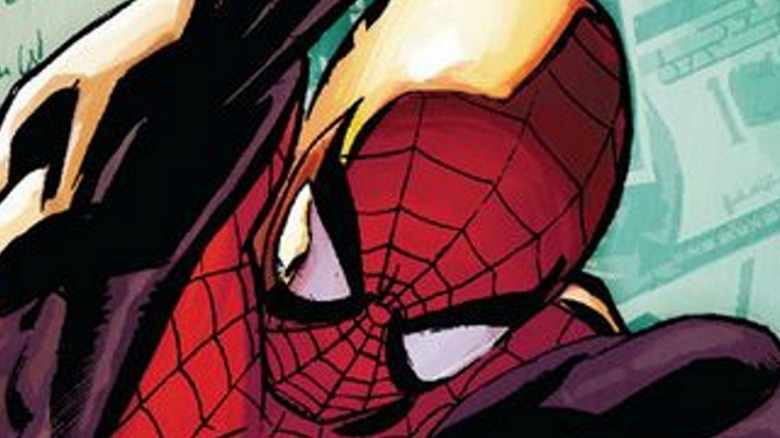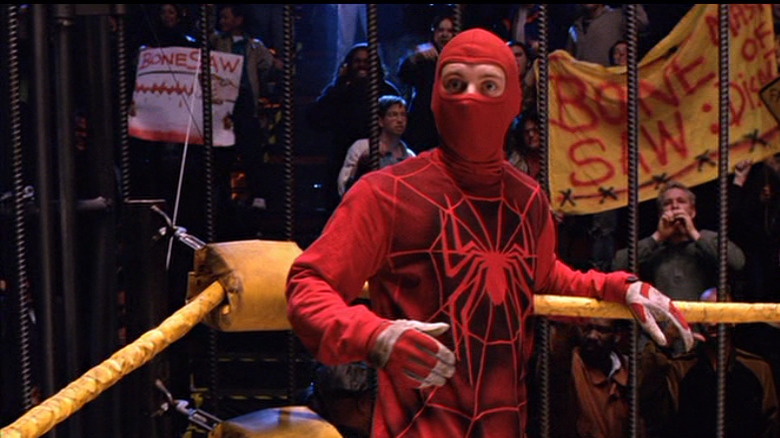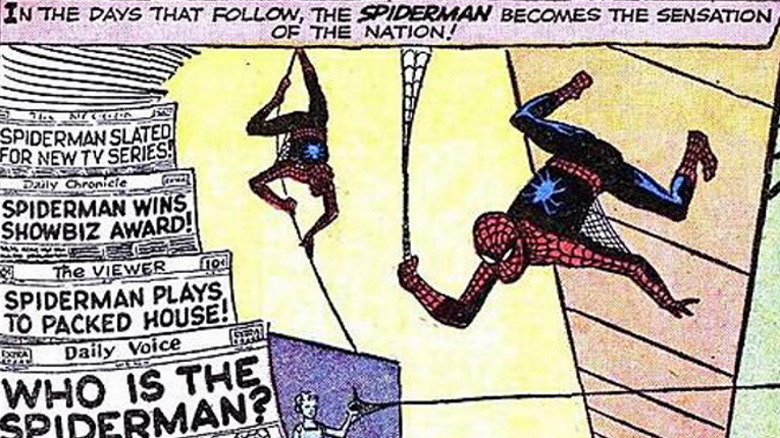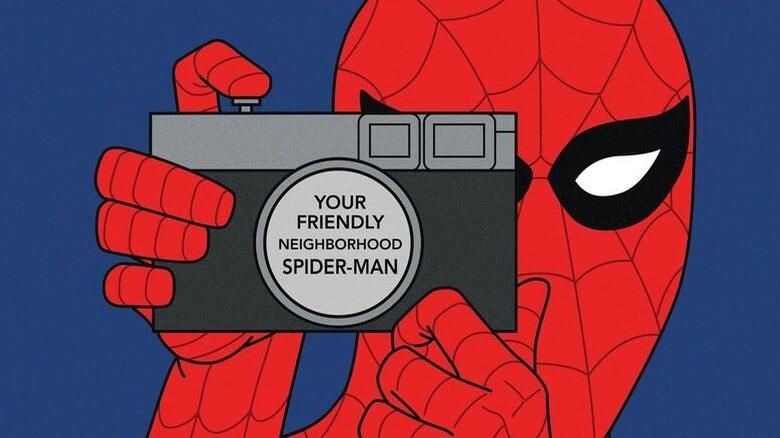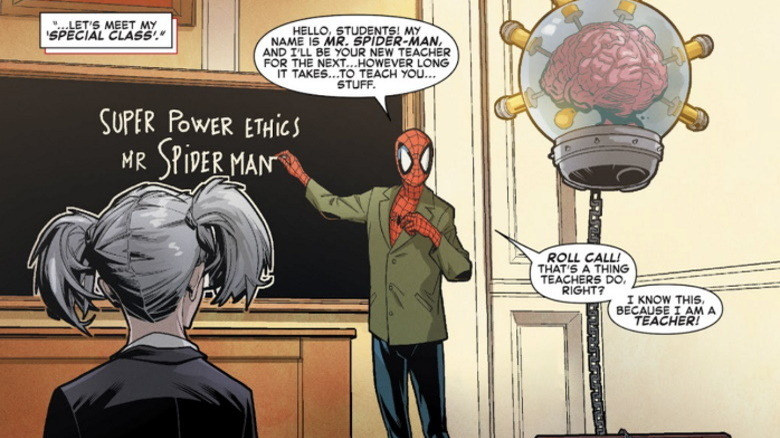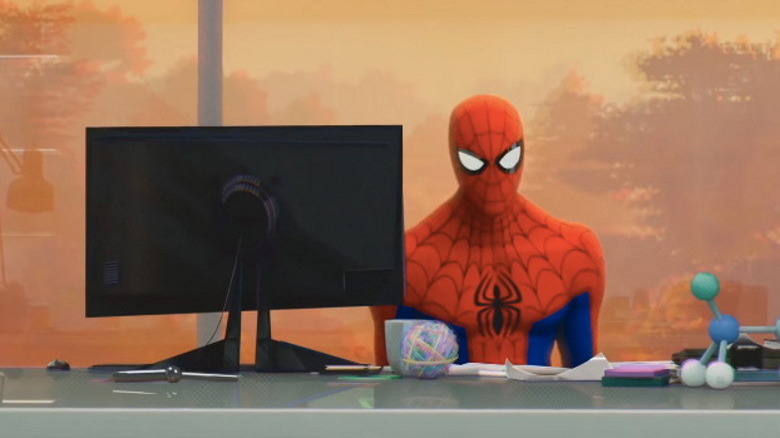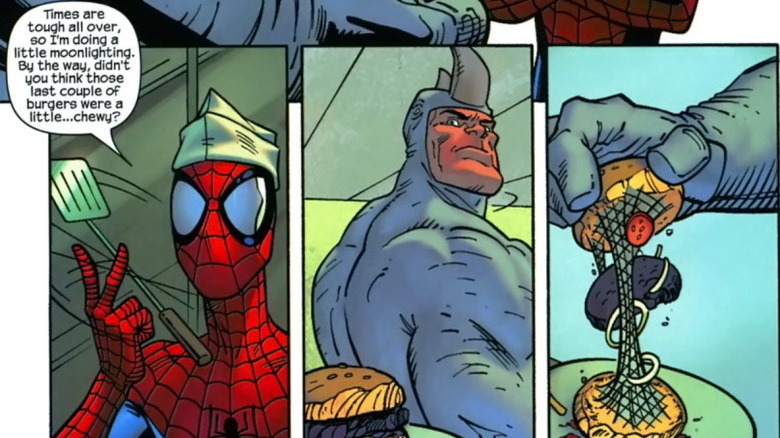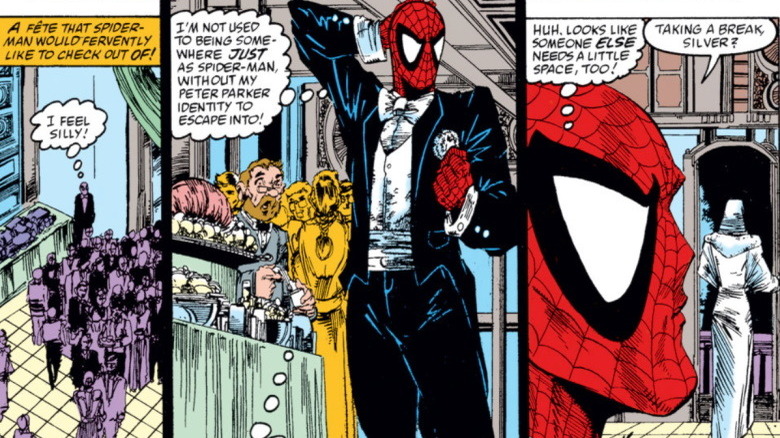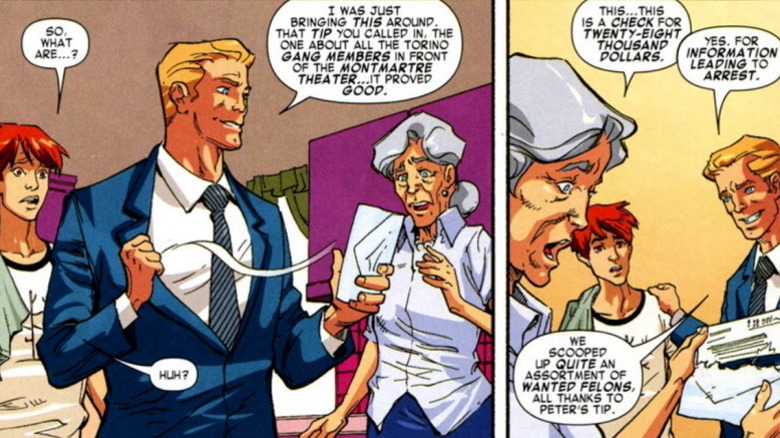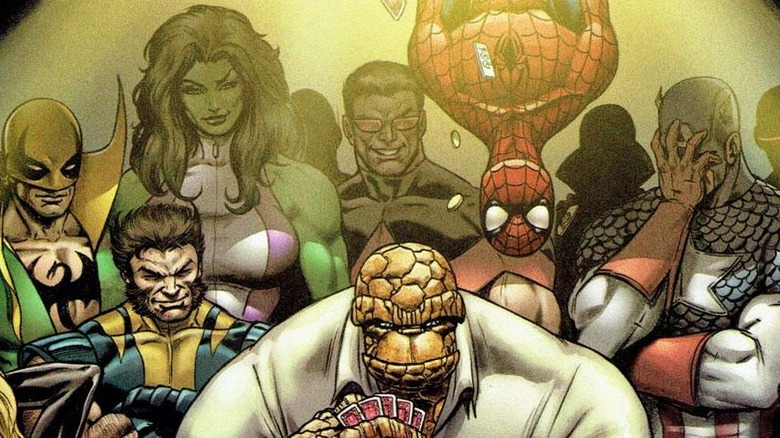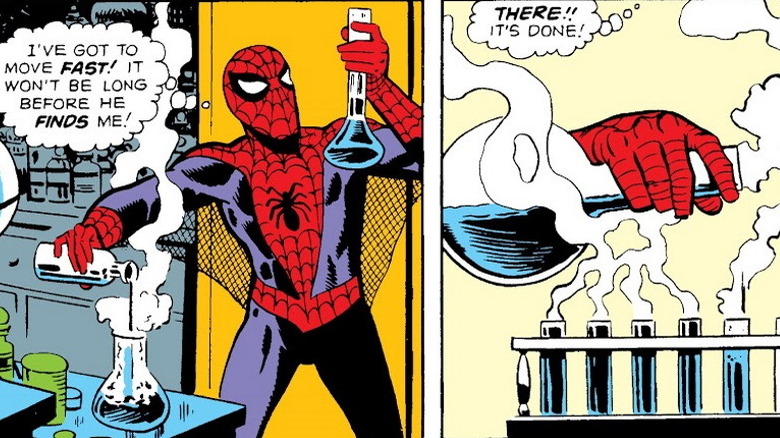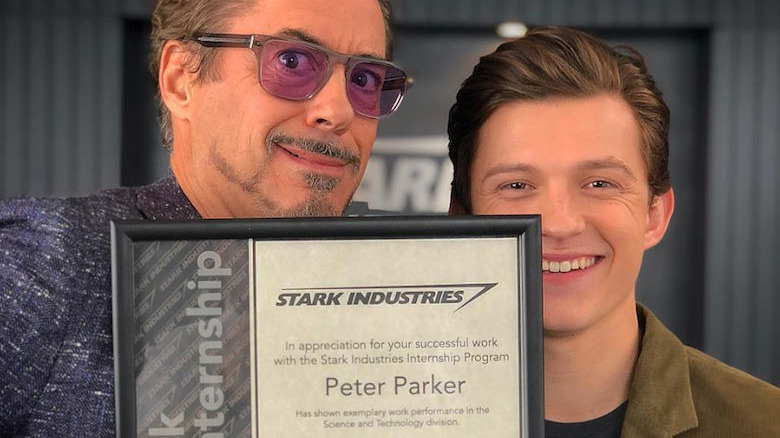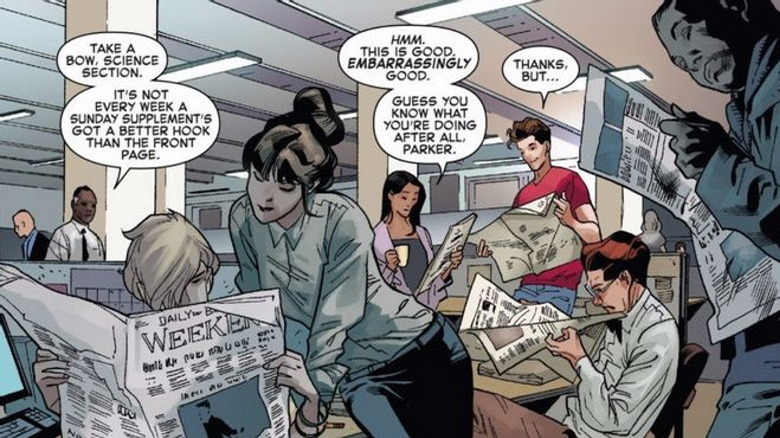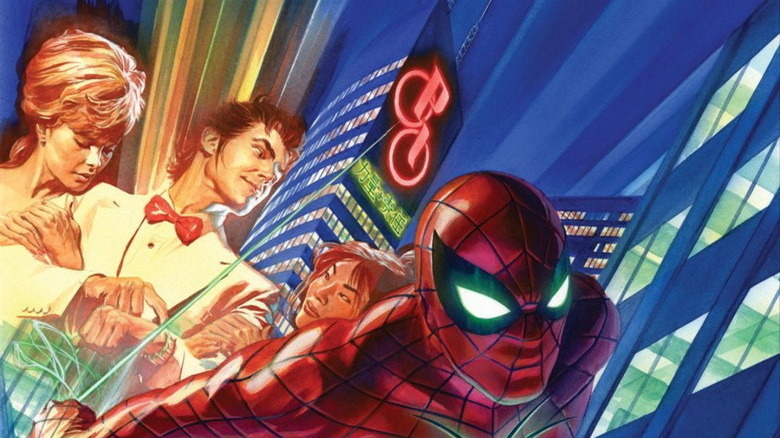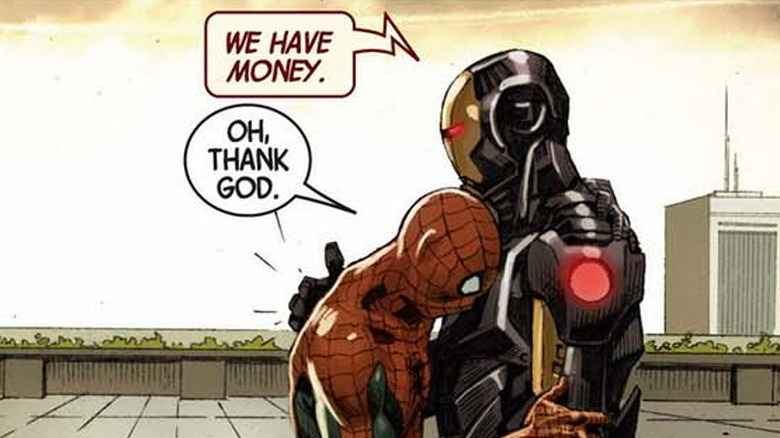All The Different Ways Spider-Man Has Made Money
While many of his MCU counterparts never seem to be hurting for money (well, except maybe Falcon), regular readers of Spider-Man comics know that Peter Parker is the original working man's hero. Whereas guys like Superman or Batman are either independently wealthy or have steady jobs to pay their bills, Peter regularly can't make ends meet. In many depictions over the years, he has barely had enough money to pay for food, let alone web fluid.
To supplement these shortcomings, Spidey has taken on some odd side-hustles over the years, both in his civilian and superhero lives. Some of these gigs have forced him to work for near-minimum wage; oddly enough, others have (temporarily) skyrocketed Peter into a Bruce Wayne or Tony Stark-like tax bracket.
So, how does someone with superpowers and a genius IQ earn a paycheck? Let's take a look at the amazing work history of our favorite webslinger, at some of the jobs he might want to omit from any applications to join super teams.
Spider-Man the wrestler
Longtime Spider-Man fans (and those who saw Sam Raimi's classic 2002 "Spider-Man" film) know that when Peter Parker first acquired his spider-powers, he didn't use them to fight crime. Instead, he did what most teenagers would try to do: cash in.
For Peter, this meant entering a wrestling contest and trying to survive in the ring with "Macho Man" Randy Savage ... er, Bone Saw McGraw ... er, "Crusher" Hogan (in the comics). Wearing a mask to conceal his identity, Peter won and collected some money on his first fight.
Comic book readers later learned there was a tragic component to the Hogan story. Turns out "Crusher" wasn't a bad guy — just a dedicated wrestler who had created an arrogant stage persona to attract bigger crowds to his matches, helping his fellow fighters support their families. In "Spider-Man's Tangled Web" #14, Crusher realized whoever could beat him would become a hero for the audience, but leave him a washout.
In "The Amazing Spider-Man" #271, we learn that Crusher went on to become a huge Spider-Man fan, and even helped the webslinger battle some extortionists threatening his friends. That's a twist any WWE fan could appreciate.
Spider-Man the TV star
Wrestling turned out to be just the first stop on Spidey's short-lived road to media stardom. Approached by an agent after his wrestling debut, Peter developed his costume and web shooters as a way to add some color to his superhuman feats. Long before "America's Got Talent" hit the airwaves, Spider-Man was wowing TV audiences with his acrobatics and wall crawling stunts. At one point, his agent even informed him that "new kid" David Letterman wanted him to appear on his show.
In fact, even after Uncle Ben was killed, Peter hoped he could still support Aunt May with his television career in "The Amazing Spider-Man" #1. Unfortunately, he ran into a snag. Apparently the bank wouldn't cash checks made out to "Spider-Man," unless Spidey could produce some valid ID. Unable to show them his driver's license — let alone, one with his name listed as "Spider-Man" — Peter backed out of show business.
Later, when the Daily Bugle's editorials branded Spider-Man a "menace," public perception toward the webslinger turned, making it impossible for Spidey to find work as a TV star. Sometimes, it seems, show business can be quite fickle.
Peter Parker the photographer
By "The Amazing Spider-Man" #2, Peter finally found the side hustle that would keep him employed for most of his superhero career — selling selfies, long before the term was coined.
With the help of Uncle Ben's old camera, Peter began taking photos of supervillains like the Vulture, as well as front page-worthy pictures of himself as Spider-Man. Since very few people could get a clear shot of Spidey, Peter's photos were eagerly purchased by The Daily Bugle newspaper (although skinflint publisher J. Jonah Jameson regularly short-changed Peter's paychecks).
Then again, Peter wasn't exactly the most honest news photographer, either. As if secretly selling photos of himself wasn't bad enough, in "The Amazing Spider-Man" #4, Peter took shots of Spider-Man punching some ordinary sand he had thrown in the air, then sold them to Jameson as photos of Spidey battling the Sandman. Such moments would seem to strain journalistic ethical standards — then again, a kid's gotta eat.
Peter's proficiency in photography has grown over the years, to the point where the Daily Bugle eventually published a coffee table book entitled "Webs," featuring all of Pete's Spider-Man photos. It sent him on a media tour — but later, in "The Awesome Slapstick" #2, it was revealed that the book was a dud and stores were selling it for $1.98 ... per pound.
Peter Parker and Spider-Man, teachers
Peter Parker is a bona fide genius. Between his love for science and desire to help others, it seemed only natural that he'd take on some teaching gigs over the years. So, while earning his college degree at Empire State University, Peter worked as a teacher's assistant, instructing freshmen in chemistry. Unfortunately, his responsibilities as Spider-Man caused him to gain a reputation as a flake among his fellow TA's, and he had to ultimately leave the job.
Some years later, Peter decided to go full "Welcome Back Kotter," returning to his old high school (Midtown High) to become a science teacher. Although he was a gifted educator who genuinely cared about his students, his regular absences once again made it hard for him to keep the job.
Amazingly, Peter has even taught classes as Spider-Man. In "Spider-Man and the X-Men," Spidey taught a "Special Class" at the Jean Grey School of Higher Learning, at the request of Wolverine. Assigned to a group of eager young mutants with names like Rockslide, Hellion, Glob Herman, Shark-Girl, Eye Boy, Ernst, and No-Girl, Spider-Man participated in a science fair against the Beast's students, even taking his kids on a quasi-field trip, patrolling against the Sinister Six. Spidey once again proved to be an effective teacher, passing on the Peter Parker principle ("With great power comes great responsibility") to the next generation of crimefighters.
Spider-Man the web designer
Over in the Ultimate Universe, a 15-year-old version of Peter Parker tried to copy his mainstream version's side hustle of selling photos of himself to the Daily Bugle in "Ultimate Spider-Man" #8. Although J. Jonah Jameson did end up buying one pic, Peter couldn't wrangle that single sale into a regular job. Given that most teenagers don't become successful freelance photographers at age 15, this seemed logical.
Peter instead proved he could be valuable to the Daily Bugle in another way — as a web developer. It seems that nobody at the office could figure out how to use their website (the issue was published in 2001, after all) until Peter's computer smarts managed to find a work-around for their issues. Unable to resist a chance to exploit the teenager, Jameson hired Peter on the spot to "work on this frakakta web site for us." As it turns out, Spidey could do even more with webs than originally thought.
Spider-Man the Short Order Cook
Sadly, Ultimate Peter Parker lost his web designer job following the events of the "Ultimatum" story that devastated New York and shut down the Daily Bugle. When we catch up with Peter in "Ultimate Comics Spider-Man" #1, he's working at the fast-food joint "Burger Frog," and apparently hating every second of it. Hilariously, the job forces Peter to don a Kermit-the-Frog-style hat, so even his usual branding was off point.
Over in the mainstream Marvel Universe, Spider-Man has done other stints in the fast-food industry. In "Spider-Man Unlimited" #13, a down-on-his-luck Spidey attempts to get free burgers from MacArthur's Café after seeing how the owner Mac comps food for police officers. Instead, Mac puts Spidey to work flipping burgers, just so he can get protection from the Rhino, who was also trying to get a free meal from the burger joint.
Spider-Man ends up serving the Rhino burgers filled with his webs (clearly a major health code violation), and starts a fight. In the end, the cops force Spidey and the Rhino to clean up their mess. Well, at least Spidey got some free sandwiches out of the deal.
Spider-Man-for-Hire
Spider-Man is one of New York's most ethical superheroes. After losing Uncle Ben due to the selfish misuse of his powers, Peter Parker has stood firmly against using his spider-powers for personal gain ... except, when he hasn't.
Take for instance, the many times Spidey has worked for Silver Sable, a professional mercenary who's paid Spider-Man a thousand dollars a day to work security for her in a foreign country. While Peter appreciated the money, he found he needed to stay in costume his whole time overseas, even dressing in a tuxedo.
In "The Amazing Spider-Man" #54, Spidey was paid twelve thousand dollars a day to protect a mobster from assassination attempts. The mobster assured Spider-Man that he wouldn't be breaking the law (and would, in fact, be paid for what he normally did for free). Spidey agreed, stopped the assassin, made sure his employer was arrested — and kept the money (which he later donated to the Gwen Stacy Memorial Library).
Not all of Spidey's mercenary jobs are so unsavory. In "Spider-Man Marvel Adventures" #3, Spider-Man got paid five thousand dollars from the Blonde Phantom Detective Agency to spy on Wolverine and make sure everyone's favorite mutant Canuck is law-abiding enough to be the face of a new men's hair gel that a cosmetics company is creating. Sounds ridiculous, but Spidey gets paid, and Wolverine goes out on a dinner date with the Blonde Phantom, so it's a win-win.
Spider-Man the Police Snitch
Spider-Man has always had a problematic relationship with the police. Although some cops appreciate the webslinger's assistance, others are convinced he's a menace. In one instance, however, Spidey's police connections paid off in a big way.
In "Marvel Adventures: Spider-Man," a young Peter Parker develops a close relationship with Captain George Stacy of the NYPD after Stacy discovers Peter's secret identity and works with him to take down an entire mob family. When Peter lets the police captain know that Aunt May needs a lot of money to repair their house, Stacy comes through in a major way.
Since Peter and George are constantly calling each other, Peter lets George know of a mob attack that Spider-Man later stops. Since the situation led to a string of arrests, Captain Stacy arranges for Peter to receive a hefty check from the city for his "tip." The money covers Aunt May's much-needed house repairs, and Peter learns that sometimes, the police really are looking out for him.
Spider-Man the gambler
Everyone knows about Spider-Man's amazing strength, but it's his most subtle power that's the real money maker. For years, Peter has used his extrasensory "spider-sense" as a way to avoid getting shot or hit. Signified by a sharp tingling in the base of his skull, the spider-sense warns Peter of all sorts of danger ... including, apparently, dangers to his wallet.
In "Spectacular Spider-Man" #21, Spidey reveals his spider-sense makes him an amazing gambler. In the story, heroes like Mr. Fantastic, the Thing, Human Torch, and Doctor Strange gather for an annual charity poker game. With the aid of his spider-sense, Spidey is able to read the entire table with ease and hold his own.
Things heat up when the Kingpin arrives, offering to stake each player $50,000 just so he can have the pleasure of beating them at their own game. However, he doesn't take into account Spidey's card-playing skills, and the webslinger easily takes the crime lord down — then promptly donates $400,000 to the Cerebral Palsy Research Foundation. He might be broke most of the time, but when he has cash, Spidey is very generous.
Spider-Man the CSI guy
So many Spider-Man stories keep him locked in a state of perpetual youth, one Peter seemingly can't break free of — or its inherent teenage menial wage jobs. However, that's not the case in Marvel's MC2 comic "Spider-Girl," which follows the adventures of Peter's teenage daughter May "Mayday" Parker, who inherits her dad's spider-powers and decides to follow in his web-steps.
Meanwhile, Peter is retired from the superhero life — but not from crime fighting. After getting his doctorate, Peter decides to use his scientific knowledge to work for the police department as a forensic scientist. With the aid of his partner Phil Urich (a formerly heroic Green Goblin), Peter scours crime scenes for evidence that can help the police put the crooks away for good.
A CSI job seems like a great fit for an older Peter Parker — and in the mainstream universe, Peter also got the chance to work as a research scientist for major companies like Horizon Labs. Since he was still Spider-Man, however, he used this position to improve his crime fighting gear, and to inspire his work projects.
Peter Parker the personal assistant
Tom Holland's high school-aged Peter Parker dreamed about working for Stark Industries in "Spider-Man: Homecoming" (2017), but sadly, with Tony Stark's passing in "Avengers: Endgame" (2019), that dream never came true.
In the comics, however, Peter did get a chance to work as Tony's personal assistant during. The job came with plenty of perks. Not only did Peter gain access to Stark's high-tech toys (and a new Iron Spider suit), but he also got to move his whole family into Avengers Tower, where they were all waited on by the butler Edwin Jarvis. And considering how much money Tony throws around on a regular basis, his paycheck had to be pretty nice too.
Unfortunately, Peter's working relationship with Tony led to Stark convincing Spider-Man to unmask to the press during the "Civil War" storyline. This caused Peter's family to be targeted by the mob and his Aunt May was shot, creating a major rift between Iron Man and Spider-Man.
Spider-Man the Science News Editor
Peter Parker's job as a freelance photographer might be a big part of his character, but after decades of taking pictures for the Daily Bugle, one would think he deserved some sort of job advancement. He finally got this chance when Robbie Robertson took over as head of the Daily Bugle, assigning Peter as news editor for the science column.
Peter actually proved to be highly adept at the job, thanks to his background. He was a capable team leader, and enjoyed finally being a full-time employee of the Bugle rather than merely a freelancer. His hours were flexible, thanks to his close relationship with Robbie Robertson, but eventually life as Spider-Man interfered, and he lost the position.
Ironically, some readers found the idea that the Daily Bugle could afford to keep a science editor on their staff of reporters even more fantastical than the idea that Peter Parker could support himself in New York just by taking photos of Spider-Man. Apparently, being a fictional character can offer some nice job prospects.
Spider-Man the Billionaire CEO
Since the 1960s, Marvel Comics has kept Peter Parker in an almost constant state of poverty. Although there have been multiple stories showing that Peter's genius intellect and superpowers could potentially make him very wealthy, Peter himself seemed to have a mental block that kept him from holding on to large amounts of money.
That is, of course, until Doctor Octopus took over Peter's body in the pages of "The Superior Spider-Man" and decided to finally get Peter's life (which was now his) in order. This meant finally earning that doctorate, and transforming himself from a penniless student into the owner of his own company, Parker Industries.
Peter eventually regained control over his body, discovering he was now CEO of a major corporation. Parker Industries managed to do quite a bit of good for the world — and Peter even stole an idea from Tony Stark by employing Spider-Man as his bodyguard — but eventually luck caught up with him and his company folded, leaving Peter once again in his default, cash-strapped state.
Spider-Man the Avenger
In the Disney+ series "The Falcon and the Winter Soldier," Sam Wilson (Anthony Mackie) suggests MCU's Avengers don't collect a paycheck and instead rely on the goodwill of others to make ends meet. Fortunately, this isn't necessarily true in the comics, where Spider-Man did get paid a decent wage during his time as an Avenger.
In "Avengers" #213, it's established that active Avengers earn $1000 a week, while reserve members receive a stipend of $100 a month. Adjusted for inflation, one article estimates this means active members currently earn $2815.60 a week while reserve Avengers receive a $281.55 monthly stipend.
Spidey initially worked as a reserve Avenger, which probably didn't make a big dent in his finances considering how expensive it is to live in New York. Later, however, he was promoted to full member. Members also get room and board at Avengers Mansion, so the job does have some pretty nice perks.
